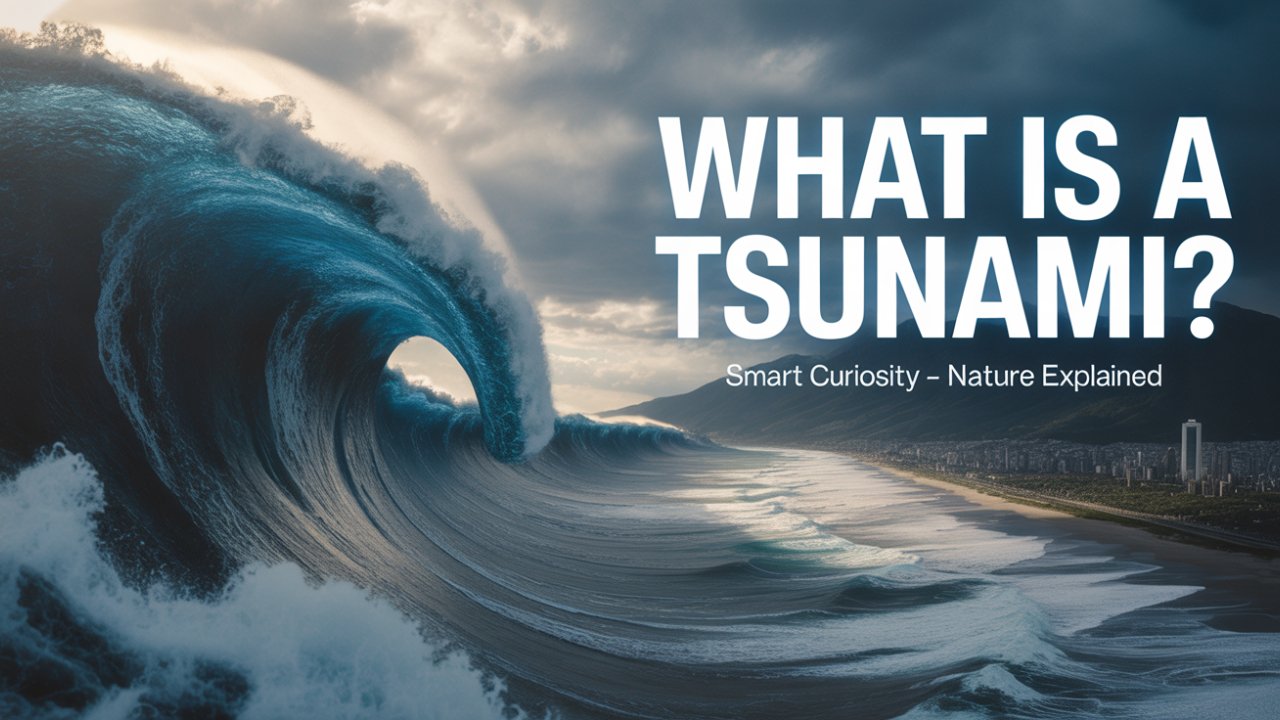It starts with a tremor, a shudder from deep inside the Earth that’s often too far away, too faint for any of us to feel. But the ocean feels it. In the crushing dark of the abyss, a huge amount of water is shoved violently upwards, and an invisible pulse of energy is born. This isn’t a wave you can see, not yet. It’s a ghost in the ocean, a silent surge racing through the depths.
Imagine a wave that can travel at the speed of a jet. It’s born from a violent explosion of geology in the crushing depths of the ocean and races invisibly from one continent to another. When it finally arrives, it doesn’t break it’s a rising wall of water that can erase entire cities. This is a tsunami. But what unleashes this kind of power? What is this force of nature? And where does it come from?
The word “tsunami” comes from the Japanese characters for “harbor” (tsu) and “wave” (nami). This name was born from the chilling experience of fishermen who, after a perfectly normal day at sea, would return to find their port completely destroyed by a monster wave they never even saw coming. That’s the terrifying paradox of a tsunami it’s invisible in the open ocean, but an absolute catastrophe at the coast.
Unlike the normal, wind-driven waves that lap at the shore, a tsunami is a completely different kind of monster. A typical ocean wave is really just a surface event, with its energy stirring only the top layer of water. A tsunami, though, is a full-column displacement. The energy moves the entire body of water, from the seafloor to the surface. That’s why it doesn’t show up as a classic, curling surf wave. Instead, it often arrives as a rapid, relentless rise in sea level a flood moving at terrifying speed, or a solid wall of churning water that just keeps coming for several minutes.
One of the most deceptive and dangerous signs of an approaching tsunami is the drawback. Sometimes, the trough of the wave arrives before the crest. When this happens, the sea recedes dramatically, exposing the seafloor, reefs, and stranded fish in a strange and tempting spectacle. In too many historical accounts, this weird phenomenon has lured curious people to the shoreline, only for them to be caught moments later by the first devastating wave. This is a critical warning: if the ocean suddenly pulls back, you run. You don’t watch.
And a tsunami is almost never just one wave. It’s a “wave train,” a series of surges that can arrive minutes or even hours apart. The first wave often isn’t even the biggest. This procession of waves can go on for a long time, grinding cities into rubble and pulling tons of debris back out to sea, which makes the destruction even worse and rescue efforts incredibly dangerous. The force is just hard to wrap your head around. Just six inches of fast-moving water can knock you off your feet. A tsunami is a flood measured in feet and meters, moving with the force of a battering ram.
To really get what’s going on, we can’t stay on the shore. We have to go to its birthplace, miles below the surface, to the violent heart of our planet.
The vast majority of tsunamis about 80% are born from the raw power of underwater earthquakes. But not just any earthquake can do it. The cause is a very specific, and very violent, type of geological event that happens where Earth’s tectonic plates smash into each other.
Our planet’s crust isn’t a solid shell. It’s a jigsaw puzzle of massive rock slabs called tectonic plates, and they’re in a constant, slow-motion crash. Where these plates meet, you get fireworks. The most powerful tsunami generators are found in subduction zones areas where a dense oceanic plate is forced to bend and slide under a lighter continental plate.
For years, decades, sometimes centuries, friction causes these two massive plates to get stuck. But the forces driving them don’t stop. The top plate starts to bend and flex under the strain, storing up an insane amount of energy, like a giant spring being compressed.
Then, in just a few minutes, the stress becomes too much for the friction to handle. The plates violently slip. This is a megathrust earthquake. The part of the top plate that was being dragged down suddenly snaps back up, and an immense area of the seabed, maybe hundreds of miles long, is shoved upwards by several feet.
Since water is practically incompressible, that sudden jolt displaces the entire column of water sitting on top of it. A massive dome of water, mirroring the shape of the uplifted seafloor, is created on the ocean’s surface. But this bulge can’t last. As gravity pulls the water back down, all that potential energy is converted into kinetic energy, sending out waves of immense power in every direction. A tsunami is born.
That vertical displacement of the seafloor is the key. Earthquakes where plates just grind past each other horizontally, called strike-slip faults, almost never cause big tsunamis because they don’t lift or drop the water column. A tsunami-generating quake has to be powerful, usually a magnitude 7.0 or higher, shallow, and it has to move the ocean floor up or down.
While earthquakes are the main culprit, other things can set off the ocean’s fury. Explosive volcanic eruptions are another big one. The 1883 eruption of Krakatoa in Indonesia is the classic example. The volcano’s massive explosion and the collapse of the island into the sea created waves over 120 feet high that killed around 36,000 people. More recently, the 2022 Hunga Tonga-Hunga Ha’apai eruption generated a tsunami whose destructive waves hit Tonga hard and sent smaller waves and pressure disturbances across the entire Pacific.
Landslides, both underwater and those that crash into the sea from the coast, are another trigger. The most extreme example is the 1958 megatsunami in Lituya Bay, Alaska. An earthquake shook an enormous amount of rock and ice into a narrow bay, creating a localized wave of unbelievable height a run-up of 1,719 feet. That’s the highest wave ever recorded.
And finally, though it’s incredibly rare, a big enough asteroid hitting the ocean would do the same thing, generating a mega-tsunami with global consequences.
Now, before we follow the wave, we need to clear something up. People often call tsunamis “tidal waves.” This is just wrong. Tides are the slow, predictable rise and fall of the sea caused by the gravity of the moon and sun. Tsunamis are caused by huge water displacement from things like earthquakes. They have nothing to do with each other, and calling it a “tidal wave” gives a totally false impression of its true, violent origins.
Once it’s born from the violent rupture of the seafloor, the tsunami starts its journey. This isn’t a trip made of towering, visible waves, but of an invisible and incredibly fast pulse of energy. The initial bulge of water splits. One part of the wave travels toward the nearest coast, often arriving in just a few minutes. The other part begins a relentless race across the entire ocean.
And here’s where the famous analogy comes in: a tsunami in the deep ocean travels at the speed of a jetliner. Its speed isn’t determined by wind, but by the depth of the water. Out in the open ocean, where it’s about 2.5 miles deep, a tsunami can race along at over 500 miles per hour. The 2004 Indian Ocean tsunami traveled at those speeds, crossing the entire basin to hit the coast of Africa, thousands of miles away, in just a matter of hours.
But here’s the great paradox: while its speed is immense, its height is tiny. Out in the deep ocean, a tsunami wave might be less than three feet tall. What makes it so different from a wind wave is its enormous wavelength the distance from one crest to the next. A normal wind wave might have a wavelength of 100 feet. A tsunami’s wavelength can be over a hundred miles long.
Because the wavelength is so huge, the slope of the wave is incredibly gentle. A ship at sea wouldn’t see or even feel a tsunami pass underneath it. It would just register as a slight, slow swell, easily lost in the normal motion of the ocean. It’s an invisible monster, a silent messenger of destruction, carrying an unimaginable amount of energy across thousands of miles with almost no loss.
The Sumatra-Andaman earthquake in 2004 released energy equivalent to 23,000 atomic bombs. A huge chunk of that energy was transferred directly into the Indian Ocean, powering the tsunami that would devastate 14 different countries.
As this energy travels, its path is bent and shaped by the mountains and trenches on the ocean floor. This can focus its energy towards some coastlines and scatter it away from others, which is why a tsunami’s impact can be so unpredictable. One town might be destroyed while its neighbor is left almost untouched.
This journey is a silent, high-speed race against time. The earthquake that triggers the wave is detected almost instantly by scientists. The question then becomes, was a tsunami actually created? And where is it going? This is the critical window where science has to outrun the wave itself.
For hours, the tsunami has been an invisible force, a high-speed pulse of energy hidden in the deep ocean. But as it gets closer to land, it starts a dramatic and deadly transformation. This process, called wave shoaling, is why a three-foot swell in the abyss becomes a 100-foot wall of destruction at the coast.
The key to this change is the relationship between the tsunami’s speed and the water depth. As the front of the wave leaves the deep ocean and hits the shallower water of the continental shelf, it starts to drag on the seafloor. This friction makes the front of the wave slow down a lot. The wave that was traveling at jet speed slows to about 50 mph. As it gets even shallower, it slows down more, to maybe 20 or 30 mph.
But all that energy has to go somewhere. Since the speed is dropping, the energy is conserved by being compressed, forcing the wave’s height to grow dramatically.
Think of it like cars on a highway. They’re all moving at high speed. If the cars at the front suddenly slam on the brakes, the cars behind them, still moving fast, start to pile up. The density of cars skyrockets. With a tsunami, the water itself piles up. The back of the incredibly long wave is still moving faster than the front, catching up and forcing the water upwards.
This process also squishes the wave’s wavelength. The wave that was a hundred miles long in the deep ocean might now be only a few miles from crest to crest. This bunching effect concentrates the energy even more and leads to that astonishing increase in height.
And it’s important to get this: a tsunami doesn’t really “break” like a normal wave. A surfing wave curls over because its base slows down more than its crest. A tsunami is so long that it acts more like a rapidly rising tide or a bore a churning, turbulent wall of water that just surges inland. This surge can go on for minutes, flooding huge areas of low-lying land, sometimes for miles.
The destructive power comes from two things: first, the smashing force of this wall of water, which can demolish buildings with ease. And second, the immense volume of water that floods the land and then drains back to the sea, carrying a slurry of debris cars, trees, pieces of buildings that acts like a liquid bulldozer, scouring the landscape clean.
The transformation is complete. The silent ghost from the deep has become a monster at the shore, ready to unleash the pent-up energy of an earthquake on the world.
When the science of geology and wave physics collides with human civilization, the result is a catastrophe. To really grasp the impact of a tsunami, we have to look at the events that are carved into our collective memory. Two disasters in the 21st century stand as terrifying proof of this power: the 2004 Indian Ocean tsunami and the 2011 Tōhoku, Japan tsunami.
On December 26, 2004, a monstrous undersea earthquake with a magnitude of 9.1 struck off the coast of Sumatra, Indonesia. It was the third-largest earthquake ever recorded, and it was so powerful it caused the entire planet to vibrate. The quake ruptured a section of the seafloor more than 700 miles long, thrusting it upwards by several feet.
The tsunami that followed was on a scale unseen in modern history. With no warning system in the Indian Ocean and very little public awareness, coastal communities were caught completely by surprise. The waves crossed the entire Indian Ocean, a “teletsunami” that brought destruction to 14 countries, some as far away as the east coast of Africa.
The final death toll was apocalyptic. An estimated 230,000 people were killed or went missing, making it one of the deadliest natural disasters in recorded history. Indonesia was hit the hardest, with the province of Aceh suffering over 170,000 deaths. Sri Lanka, India, and Thailand also lost tens of thousands of people. Entire towns were simply wiped off the map. The disaster was a brutal wake-up call, and it led to the creation of the Indian Ocean Tsunami Warning System.
Less than seven years later, the world watched in horror as history repeated itself, this time in one of the most prepared nations on Earth. On March 11, 2011, a magnitude 9.1 earthquake, the most powerful ever recorded in Japan, struck off the Tōhoku coast. The quake was devastating, but the tsunami it unleashed was a catastrophe of a different order.
Despite Japan’s sophisticated warning systems, the tsunami was simply overwhelming. In some places, waves reached heights of nearly 130 feet, pouring over massive seawalls that were built to protect coastal towns. The water surged up to six miles inland.
The human toll was immense, with nearly 20,000 people dead or missing over 90% of them from drowning. But the impact didn’t stop there. The tsunami flooded the Fukushima Daiichi Nuclear Power Plant, knocking out its cooling systems and triggering a catastrophic nuclear accident with three reactor meltdowns. This second disaster forced the evacuation of hundreds of thousands of people and created a long-lasting environmental crisis. It was the costliest natural disaster in history, and a brutal reminder that even the best preparations can be defeated by the raw power of nature.
In the terrifying race between a tsunami and the coast, every single second counts. We can’t stop these waves, but science and technology have given us a crucial head start: the ability to listen to the planet’s warnings and predict a tsunami’s arrival.
The first line of defense is the global network of seismographs. When a powerful earthquake happens under the ocean, the seismic waves it creates travel through the Earth way faster than the tsunami travels through the water. These waves are detected within minutes by sensors around the world, letting scientists at tsunami warning centers pinpoint the earthquake’s location, magnitude, and depth.
If the earthquake looks like it’s capable of generating a tsunami, a tsunami watch is issued. This is the first alert a signal that something dangerous might be on the way.
But an earthquake’s stats alone can’t confirm a tsunami has actually been created. For that, you have to listen to the ocean itself. And that’s the job of the DART system, which stands for Deep-ocean Assessment and Reporting of Tsunami.
A DART station is a brilliant piece of engineering. On the seafloor, thousands of feet down, there’s a pressure recorder that can detect tiny changes in the height of the water above it we’re talking less than a millimeter. When the long wave of a tsunami passes over, the recorder picks up the distinct change in pressure. It then sends an acoustic signal up to a buoy on the surface, which beams the data via satellite to warning centers in near real-time.
This is the smoking gun. The DART buoy provides hard evidence that a tsunami exists and tells scientists how big it is out in the open ocean. Today, a network of these buoys stands as silent sentinels in the world’s oceans.
With this confirmed data, scientists can upgrade a watch to a full-blown tsunami warning a signal that a dangerous tsunami is on its way. They use computer models to forecast its path, arrival times, and potential height. That information is then blasted out through every channel possible: mobile alerts, TV, radio, and outdoor sirens.
This whole system buys coastal communities the one thing they need most: time. The hours between the earthquake and the tsunami’s arrival can be used to evacuate people to high ground.
Of course, for a tsunami created by a nearby earthquake, the warning time can be just a few minutes. In those cases, the most important warnings are the natural ones: an earthquake so strong it’s hard to stand, a sudden and bizarre retreat or rise of the ocean, or a loud roar coming from the sea.
Understanding the science of a tsunami isn’t just for scientists it’s about survival. It’s what allows us to build stronger communities, to listen for the warnings, and to respect the incredible power of our planet. The journey of a tsunami, from a violent crack in the Earth’s crust to a devastating wave on a distant shore, is a powerful reminder of the dynamic world we live in. By continuing to study these forces, improve our warning systems, and educate communities at risk, we can honor the memory of those we’ve lost and give future generations the tools they need to stay safe.





